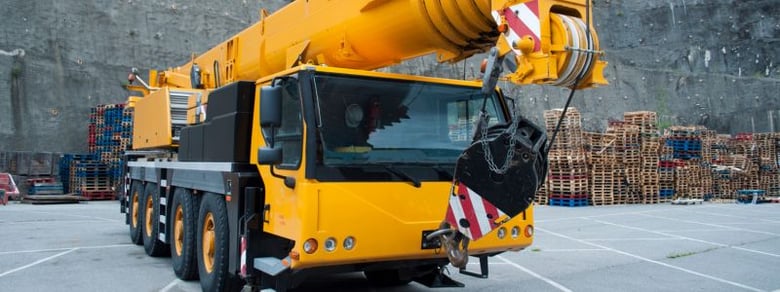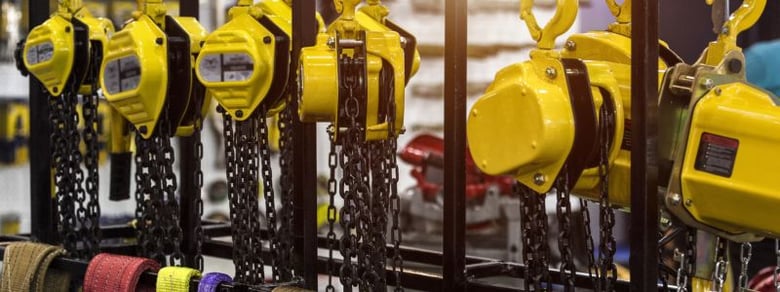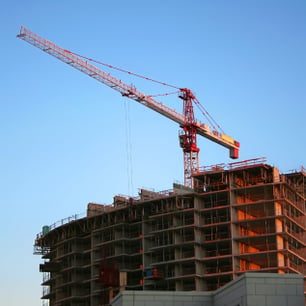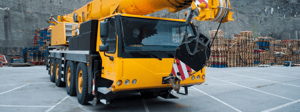Lifting equipment is essential in many people's daily lives and is often found in industrial operations, construction sites, transportation, and warehouse handling.
With the right equipment, you can ensure that you lift and handle objects safely and efficiently. In this article, we will take a closer look at what lifting equipment is and what is crucial to ensure both your own and others' safety, and how you can streamline your operations operations.
What is Lifting Equipment?
Lifting equipment is a working tool or instrument designed to lift, lower, or move heavy objects safely, efficiently, and with less effort. The equipment reduces the need for manual processes and decreases the risk of injuries on both people and other objects.
The Different Types of Lifting Equipment
Lifting equipment is crucial for many operations, and there is a wide range of equipment designed for various purposes and loads.
Cranes
 Cranes are powerful machines designed to lift and move heavy objects over short distances. Cranes lift and lower objects using an arm, winch, or loop and come in different variations.
Cranes are powerful machines designed to lift and move heavy objects over short distances. Cranes lift and lower objects using an arm, winch, or loop and come in different variations.
-
Tower cranes: These are often the tall cranes you see at construction sites. They are ideal for lifting heavy objects high, have a large radius, and require limited support.
-
Mobile cranes: These are cranes mounted on trucks or other vehicles that can be moved from place to place and quickly assembled. They are flexible and often used in road construction and other temporary projects.
-
Bridge cranes: You often find these in industrial settings like shipyards or large warehouses. These are cranes that run on rails and can cover large areas.
A crane's lifting capacity is determined by its design, materials, construction, and the specifications it was built for. This is often referred to as the crane's "maximum lifting capacity" and should never be exceeded.
Lifting Chains
Lifting chains are strong chains made of high-quality steel, designed to lift and secure heavy loads. They are often used in combination with other lifting tools like cranes and hoists to provide additional support and safety.
Fiber Slings

Fiber straps, often called round slings, are flexible bands, often made of polyester, nylon, or steel. They work by being attached around the object they are to lift and connected to a lifting mechanism. They are known for their versatility and can be adapted to handle different shapes and sizes of loads. It is essential to choose the right type and strength of the strap based on the weight of the load.
Hoists
%20(3).jpg?width=800&height=300&name=Uten%20navn%20(800%20%C3%97%20300%20px)%20(3).jpg)
Hoists are mechanical devices that use pulleys, chains, or ropes to lift and lower objects. Hoists are designed to reduce the amount of force required by exploiting the principle of mechanical advantage. They can be manual, electric, or pneumatic.
- Chain Hoists: Chain hoists use chains to lift loads and can be manual or powered by a motor.
- Wire Hoists: Wire hoists use steel wire as a lifting medium and are known for their strength and durability.
Shackles
Shackles are U-shaped metal pieces, often made of steel, with a pin or bolt across the opening. They are used to connect lifting equipment like chains, ropes, or straps. Shackles are essential for ensuring that the load is securely attached and supported during lifting.
Lifting Beams
A lifting beam is a vital tool in lifting equipment used to lift and transport heavy loads. It is a frame designed to distribute the weight of a load over a larger area, allowing heavier objects to be lifted than would be possible with only one lifting point.
Lifting beams are usually made of steel or aluminum and come in various sizes and capacities. They can be fixed, adjustable, or even specially designed for a particular job. Fixed lifting beams have fixed distances between the lifting points, while adjustable lifting beams can be changed to fit different load widths.
Smaller Lifting Equipment is Just as Important as Large Ones

Even if the smaller lifting tools seem simple, they play a critical role in lifting operations. They ensure that the load is not only lifted efficiently but also safely.
Strict Rules and Regulations for Use, Maintenance, Inspections, and Certification
In Norway, there are strict rules and regulations governing the use, maintenance, inspections, and certification of lifting equipment, including smaller lifting tools. These rules are designed to ensure the safety of you using the equipment and those working near it.
The Norwegian Labour Inspection Authority has developed regulations covering the use of work equipment, including lifting equipment. These regulations provide you with guidelines for the proper use, maintenance, and inspection of the equipment.
It is essential to be familiar with the correct use and maintenance of these tools to ensure workplace safety. Incorrect use can lead to dangerous situations and can have fatal consequences.
Before using the equipment, you should check the equipment's general condition: Look for visible damage, check all moving parts for correct function, and ensure all safety mechanisms are in place and working as they should.
Inspection and Maintenance of Lifting Equipment
Lifting equipment must be regularly inspected by a qualified person or organization. The equipment should be checked regularly, depending on usage. Some devices require a daily check, while others can be inspected weekly or monthly. An annual review by an expert is also essential.
There are requirements for expert inspection of equipment such as cranes, elevators, hoists, and other lifting equipment operating under specific loads or in particular environments. For smaller lifting gear, like shackles, slings, and chains, this might be an annual inspection, but the frequency can vary based on the type of equipment and usage conditions.
All expert checks must be documented, and this documentation should be available for inspection upon request.
Documentation Requirements
All work equipment must have the necessary certificates or documentation confirming that it meets the required standards and has been tested, inspected, and approved by an expert. This may include conformity declarations, instructions, and certificates for periodic inspections.
Certification of New Equipment
The work equipment must be certified by a competent organization before use. This ensures that the equipment is in good condition and safe to use. Only qualified and certified expert organizations or individuals can certify work equipment.
The equipment should be certified at least once a year, but the frequency can vary based on the type of equipment and usage conditions.
Training
Training is a crucial aspect of safe and effective use of lifting equipment. No matter how advanced or reliable the equipment is, there is always a risk involved when lifting and moving heavy objects. Proper training can significantly minimize this risk.
- Basic training: This training should cover basic knowledge about different types of lifting equipment, their capacities and limitations, as well as general safety procedures. This can include how to choose the right equipment for the job, how to inspect the equipment for damages or wear, and how to attach and lift the load correctly.
- Practical training: After completing basic training, operators should gain practical experience under the supervision of an experienced instructor. This will give them the opportunity to apply what they have learned in practice and become familiar with how the equipment feels and reacts under various conditions.
- Certification: In many countries, operators of lifting equipment are required to be certified. This usually involves completing an approved training course and passing an exam. Requirements can vary from country to country. Therefore, checking local regulations is essential.
- Maintenance and inspection: Training should also cover proper maintenance and inspection of the equipment. This is crucial to ensure that the equipment is in good condition and safe to use.
Labeling of Lifting Equipment:
All lifting equipment should be clearly marked with essential information, such as maximum lifting capacity, maximum working load, manufacturer's name, production year, and any other relevant specifications.
Equipment that can be used to lift people, but is not designed for that purpose, should be clearly marked with a prohibition against lifting people.
Inspection Tag for Periodic Expert Inspection
Once the work equipment is approved, it must be marked with an inspection tag in an appropriate place. Ideally, the inspection tag should be a sticker of a size and design that makes it easily visible upon inspection. Alternatively, a QR code that is easy to read and visible can be used in place of an inspection tag, with the following information:
- Name of the expert company
- Name of the certifying body that certified the expert company
- When the next inspection is due (month and year), or when the inspection was conducted
Colors of the year for Norway

If the size, design, or use of the equipment makes it impractical to use a sticker or a QR code, it is recommended to use the color assigned for the current year. This color is valid for the year the inspection was conducted and applies throughout the inspection period. A drawback of using the color of the year is that it does not provide any indication if anything has happened to the equipment after the color was applied.
You can also make use of RFID or NFC technology to access documentation and equipment information. The disadvantage with RFID is that you need a separate RFID reader to scan the RFID tag, in addition, you have to use an RFID writer to link equipment to the chip. NFC, on the other hand, is currently supported by most smartphones and can be used as easily as with a QR code; you simply hold your phone close to the NFC chip, and the information is right in front of you.
How can I organize my lifting equipment?
With Onix Work, your company can have full control over all lifting and work equipment. Onix Work is a digital solution that helps you keep track of expert inspections and all your lifting equipment in one place. This can include your technical specifications, maintenance history, inspection reports, certifications, and more. Additionally, you can easily place QR codes on your equipment, providing easy access to documents and equipment information. This simplifies maintenance planning and ensures that you have all the necessary documentation readily available.
More from our blog






